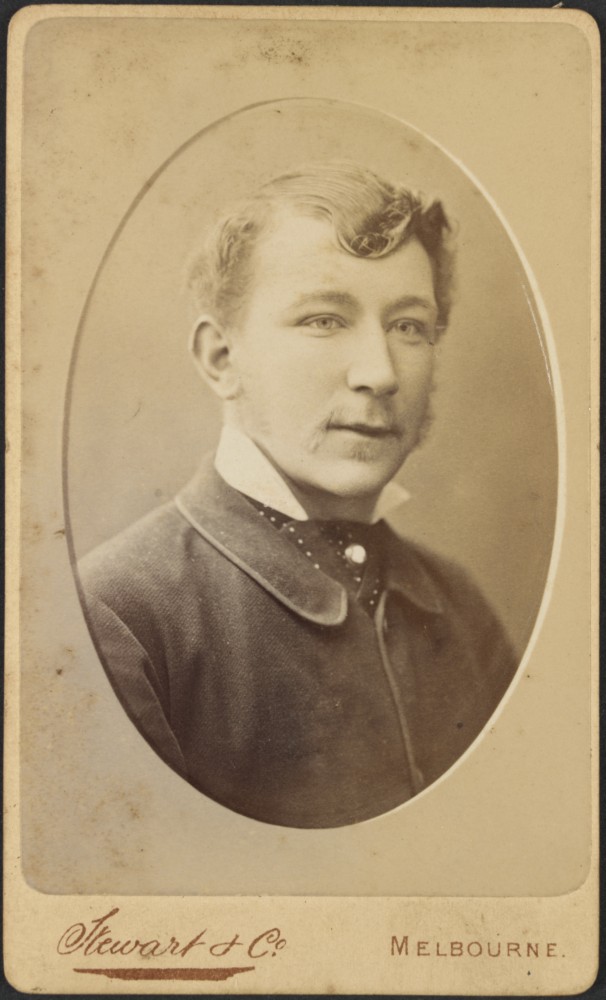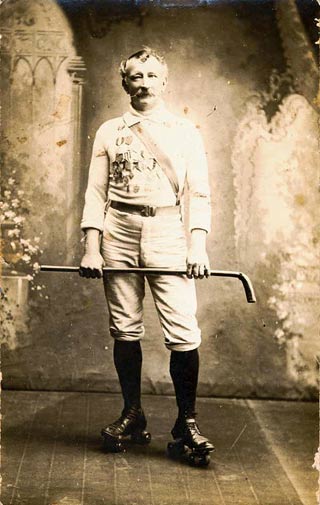

Frank Beyer, undated. The medals held by the State Library of Victoria are documented in the Historical Notes section.
CAREER SUMMARY
Birth
1860
Melbourne Vic Australia
Died
1937
Melbourne Vic Australia
Clubs
Crystal Palace Roller Polo Team
Life Memberships
Not known
"The Father of Skating"
BORN IN 1860 IN BOROONDARRA, MELBOURNE, Frank Beyer was one of twelve children of Hamburg-born gymnastics teacher Johann Carston Peter Beyer and Mary Elizabeth Horn. Known as the "Father of Skating” in Australia, he grew up at Golden Hope Cottage, Alfred Street, College Lawn, in the inner Melbourne suburb of Prahran. He ran a barber shop at 87 Chapel Street while still a teenager, then a bicycle stables known as F P C Beyer Cycle Works. He was the importer of Winslow roller skates to Australia, and Wirth Brothers were his main competitor in the local skating industry.
Forty-five years later, Frank Beyer purchased the 1860s mansion Oakrood at the end of the beach tramline near the corner of Barkly and Acland streets in St Kilda. He opened the Elite Skating Rink and Biograph there on 15 April 1911, half in the open-air gardens designed by Baron von Mueller, the architect of the Melbourne Botanic Gardens. His wife Janet used Oakrood as tearooms to host garden parties, fetes and weddings. Patrons climbed up stairs to a platform where they could "take tea in the trees".
The 1912 rink building had a concrete floor finished with ‘liquid glass’. Surrounded by spectator seating, it boasted a buffet and a bandstand for Herr Sonderhof’s Orchestra. The Beyers could convert the rink to an open-air picture theatre seating 3000.
Dan Clifton, Beyer’s grandson, said his grandfather was a victim of anti-German feelings at the beginning of the First World War, and this may have prompted leasing the building to others for picture theatres. ”Grandfather became interested in pictures when the skating craze faded“. [487] Beyer sold the property, which became the Palais (March 1915-1918), and the Barkly (January 1918-1921) before its demolition in 1937.
Around the turn of the last century, Beyer formed a business partnership with R G Webb, a successful real estate auctioneer from Freemantle, WA. They promoted and developed roller rinks in Melbourne and country Victoria, Adelaide, Brisbane and New Zealand. Olympia Skating Rink was set up in the New Plymouth Drill Hall at Taranaki in the early 1900s. Like its Australian counterparts, the Olympia hosted roller hockey matches.
Webb usually directed these enterprises and sometimes officiated roller polo. Beyer, the general manager and a former Australian roller skating champion, had played competition roller polo for many years. It was played on ice in 1904 at Adelaide Glaciarium, the first ice rink in Australia.
In 1905, Webb and Beyer resurrected the Centennial Exhibition Skating Rink, established in 1888 by the American A N Ridgley in the Exhibition Buildings Adelaide with Professor John Charles Gerald Caldwell, "the Champion Roller Skater of Australia". Caldwell trained many of the first ice skaters in the first ice rinks in Adelaide and Melbourne. Roller rinks were usually short-lived, operating for months until each new craze ran out. In Adelaide, the pair employed a staff of 39 instructors, repairers, attendants, oilers, and musicians.
At 44 in 1904, Beyer had been involved in roller rinks for 22 years, noting "the pastime had only been around for 35 years altogether, having been invented by Mr James L Plimpton of New York”. [489] He also managed the Crystal Palace roller rink in Bridge Road, Richmond, the Jubilee Skating rink in Nicholson Street, Carlton, and he held interest in the Olympia Skating Rink in Brisbane, owned by Edward Carroll.
In 1908, the Wirth brothers won the State Government tender to develop an entertainment complex beside the Yarra amid accusations of corruption by Beyer and the general public. Wirth's Palais de Luxe roller rink opened next year opposite the Glaciarium. A mosaic tile mural under the covered walkway of the Victorian Arts Centre celebrates the Wirth Brothers’ Circus, which occupied the site for decades. Melbourne had a roller polo league, aka roller hockey with themed fancy dress competitions and prizes for the best costume. The Beyers invited their audiences to men’s speed skating races and endurance skating. Percy Freeman broke the world endurance record at the Crystal Palace Rink in Richmond, skating non-stop for 64 hours on 4 December 1909.
Five Beyer daughters could have formed the Victorian Roller Polo team in their own right. Hilda and her sister Rubena were among the best pro roller skaters and roller polo players anywhere. [488] Hilda, a sporting celebrity at twenty-seven, toured the rinks of the world in Sri Lanka, Norway, Italy, Germany, France, England and New York. Their exhibitions at local rinks were important in the development of Australian skating.
The Glideaway Skating Rink in South Brisbane billed them as "Fancy Lady Skaters... the Champion lady skaters and polo team of Australia headed by Misses Hilda and Ruby Beyer". They had played for years by the time Hilda captained the Crystal Palace roller polo team to the defeat of the Jubilee rink team from Carlton in the Ladies' Polo Match in 1908. The State Library of Victoria has some of the medals they won. In 1911, Colonel Samuel Ellsworth Winslow presented Hilda with a pair of Winslow skates in New York.
Among the Beyer memorabilia left by Clifton is a copper item possibly from the Hotel Chelsea, New York, with the words: "From The Chelsea Residential Hotel Committee To F.P.C. Beyer Esq. Wishing Him Bon Voyage And Safe Return, 22 May 1924".
With engineered ice rinks, ice sports could operate anywhere all year round, and ice hockey and ice skating were mainstream sports by the late 1890s. Australia and America commenced ice hockey within a decade of each other, forging a unique and lasting bond from the time of the first-ever organised game in Melbourne in 1906 against a visiting warship from New York.
At the turn of the last century, London, New York, Montréal and Ottawa were centres of excellence for ice sports but also centres of all kinds of related entertainment, from circuses to theatre to the talkies. Melbourne organisers had forged multiple links to all four cities by the end of their first decade, a well-travelled circuit around which all kinds of international trade revolved.
Frank Beyer died in 1937 in St Kilda, Australia. He was 76.
1. Franks parents were Johann Carston Peter Beyer (~1834-1888) and Mary Elizabeth Horn (1836-1896). In 1882 he married Janet McAlpine (1859-1941), the daughter of Scottish-born parents born in Sale, Victoria.
2. The College Lawn estate was commenced in 1871 and situated between St Kilda Road and Prahran Railway Station, although some housing existed there from the 1850s.
3. R G Webb claimed to have established roller rinks in Britain at Newcastle-on-Tyne, Exeter, Bristol, Dublin, Edinburgh, Glasgow, Bath, Birmingham and Sheffield; various places in America; in South Africa at Johannesburg, Kimberley, Pretoria, Capetown, Port Elizabeth and Pietermaritzburg Durban, Ladysmith, Harrismith; in India at Bombay and Calcutta; Burma; Oamaru in New Zealand (Olympia Elite Roller Rink, 1904); Tasmania; and most of the Australian states.
4. Hilda was born in 1884 and died in 1944. Rubena was born in 1887.
5. James Leonard Plimpton (1828 – 1911) was an American inventor born in Medfield, Massachusetts who is known for changing the skating world with his roller skates. His patented 1863 design included a pair of wheels in the front, and another pair in the rear of the chassis; a truck that had a pivot motion; a rubber cushion on each truck, so that the skater could lean in the direction of the turn (lobe); and toe and heel clamps which he replaced with straps and buckles in 1866. He was the father of the quad roller skates, and of the business and sport of roller, or inline, skating as we know it today. He owned a furniture business in New York City, where he had a skating floor installed and began the business of leasing his roller skates. He converted the Atlantic House Ballroom in Newport, Rhode Island, into a skating rink and opened it to the general public in 1866; the first ever "general skating session". He founded the first roller rinks in New York, and the New York Roller Skating Association (NYRSA) in order to promote roller skating as an American pastime. Upset by patent infringements, he developed a ‘proficiency test program,’ so that skaters who chose to use his skates could be rewarded with a medal of proficiency. By 1870, his tests and medals were being given in twenty countries, including Australia.
Although George Coppin in Melbourne imported two hundred pairs of skates from Plimpton in 1866, his ice and roller skate design patented from Hobart the same year was certainly "inspired" by Plimpton's 1863 skate. In fact, the image in the patent application looks like a Plimpton skate and the skate's specification is the same. Moreover, Coppin's application in March 1866 was only the first of the spate of skate patents in Victoria that year. Leopold Burmeister followed on June 11th. Thomas Rea applied on June 20th for a skate "...with single line of rollers each revolving on two centres or sockets". On July 19th John Frederick Droop patented a method of "guiding skates by the inclination and pressure of the foot". On August 4th, William Bourne Say applied unsuccessfully to patent a skate with "(1) a mode of obtaining a rocking motion; (2) facilitation of turning; (3) metal axle box; and (4) wheels made in a single piece." On September 1st, Robert Anderson applied to patent "...an arrangement of a ball-and-socket joint, by means of which curvilinear motion is secured." It too was refused and Victoria's patent office saw no more until Horace Kimball applied on May 9th 1871. [510] These years were the dawn of Plimpton's worldwide ‘roller skating craze’, and yet Plimpton's former manager, Robert J Aginton, and the Winslow Skate Co, were to contribute even more to Australian skating.
6. George Selth Coppin (1819 – 1906), the comic actor and entrepreneur, was first to introduce roller skating to Melbourne from his Apollo Music Hall in Bourke Street. That was in 1866, the same year the world's first ever "general skating session" was conducted by James Plimpton in America. Coppin imported "rinking" on his return from a successful tour of the USA with British actors Charles Kean and his wife Ellen (Tree). [503] Coppin was the Kean's agent at the time and they were in America between 1864 and early-1866 at the dawn of the "rinking" craze. Coppin engaged Professor Fuller from New York, "the champion skater of the world," for exhibitions and instruction back home in Melbourne. Boston-born William H Fuller was the American Champion in 1865 and 1866, succeeding Jackson Haines (1840-1876), the father of modern figure skating. [506] Fuller"introduced roller skating to the Australian public" after a performance of Twelfth Night at the Apollo on the 7th April 1866. [507] The author of Roller Skating Made Easy wrote in 1884:
In writing of modern skating, it is interesting now to recall the record of Mr William H Fuller, a young American, who left New York in 1865, and gave exhibitions of roller skating while crossing the continent to California. From San Francisco he sailed to Australia, practicing on shipboard during the voyage. After remaining many months in Australia he went to India, Turkey, Egypt, and then to Russia, in the frozen North, where one might naturally expect to find skating in its greatest perfection ; and even there he "astonished the natives" by his skill in "figure skating," such as seemed marvelous to the Russians. [505]
7. Medals presented to Francis Peter Charles Beyer (probably the ones Beyer is wearing in the photo), daughters Hilda and Ruby, and unknowns for roller skating (State Library Victoria with related material in Australian Manuscripts Collection, MS 11811).
a. Order of St Andrew (Anglican Ecumenical Religious Order).
b. Silver medal with yellow and black ribbon. Words on medal: "St. Andrews Gala. Nov. 9th, 1886. Presented by Geo. H. Armfield. Won by F.P.C. Beyer. St. Andrews Handicap, 2nd Highest Number of Points. Armfield, Collingwood"
c. Silver medal with yellow and black ribbon. Words on medal: "St. Andrews Gala. 1887. Presented by G.H. Armfield. St. Andrews Handicap Gala won by F.P.C. Beyer, 2nd Highest Number of Points. Collingwood, Armfield"
d. Silver medal with yellow and black ribbon. Words on medal: "Nov. 9, 1888. St. Andrews Handicap. Presented by Geo. H. Armfield. Won by Bro. F.P.C. Beyer"
e. Silver medal, no wording. Image on silver shield of a footballer kicking a football.
f. Badge with light blue shield over a scroll banner. Words read: "C.N." "Labor Omnia Vincit" (Hard Work Conquers All)
g. Silver medal with star shaped centre, and blue and red ribbon
h. Four leaf clover shaped silver medal with a circular centre, and blue and white ribbon
i. Silver medal without wording, with blue and white ribbon
j. Silver medal with words: "HDCP Singles G.M. 1902
k. Silver medal with red, white, and blue ribbon. Words on medal: "Polo on Skates. Crystal Palace, Sth Yarra. Won by F.P.C. Beyer, 7.8.07"
l. Gold medal in shape of shield with blue and white ribbon. Wording on medal: "Polo Challenge Match, 19.3.08. Won by Carlton Skating Club. F.P.C. Beyer"
m. Gold medal with light blue and white ribbon. Wording on medal: "Polo Match Won by Carlton Skating Rink, 14.4.08. 9 Ct. F.P.C. Beyer"
n. Gold medal with image of a fort, with blue and white ribbon. Words on medal: "C.P. P.C. Premiers 1908. Won by F.P.C. Beyer"
o. Gold medal with initials "F.B." on front, with blue white and red ribbon. On verso "Pres. to F. Beyer by Patrons of Olympia Skating Rink, 20.3.09. (9Ct.)"
p. Gold pin, with words: "S.S.C. 1915. First Marching"
q. Copper item, with words: "From The Chelsea Residential Hotel Committee To F.P.C. Beyer Esq. Wishing Him Bon Voyage And Safe Return, May 22nd 1924
Rubena Beyer (nee Clifton) and Hilda Beyer
r. Gold medal. Words on medal: "First Ladies Polo Match, Jubilee v. Crystal Palace. Won by Hilda Beyer, Capt. C.P. 12.8.08"
s. [Silver medal with light blue and white ribbon. Words on medal: "Presented to Madme. Franzin [L?] by Messrs. Beyers & Caldwell, Centennial Skating Rink"] --
[t. Gold pin in shape of shield. Words on medal: "Ladies Polo Match. 13.6.04. 9C. Jubilee Skating Rink"]
u. [Gold medal with the initials "H.B." on front. Words on medal: "Crystal Palace. Lady's Skating Polo Team Won by Hilda Beyer Comptn. Nover. 08"]
v. [Gold medal. Words on medal: "Presented to Ruby Beyer Capt., Polo Match, Crystal Palace v. Jubilee, for Sterling Play. 12.8.08"]
8. George Hubert Armfield ( - 1928), 38 Stanley-street, Collingwood, watch- maker and jeweller. Amfield was one of the first silversmiths in Victoria, won 4th place at the 1888 World Fair, Melbourne Exhibition Buildings, and made all the clocks in Collingwood Town Hall.
Ross Carpenter, 'Beyer, Frank (1860-1937)', Legends of Australian Ice, Melbourne, Australia, http://icelegendsaustralia.com/bio-amess.html, accessed online .

